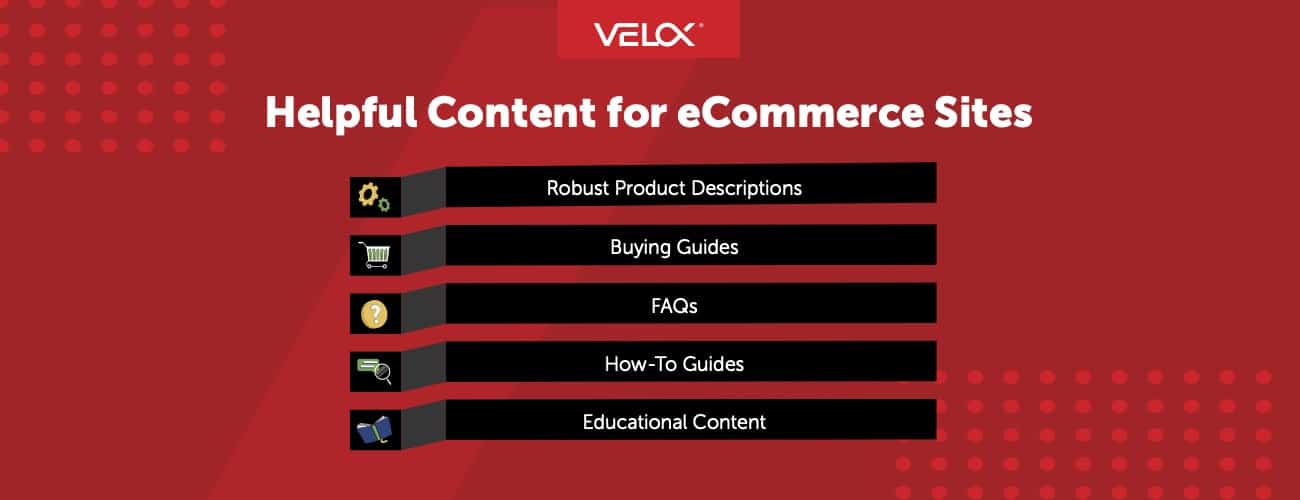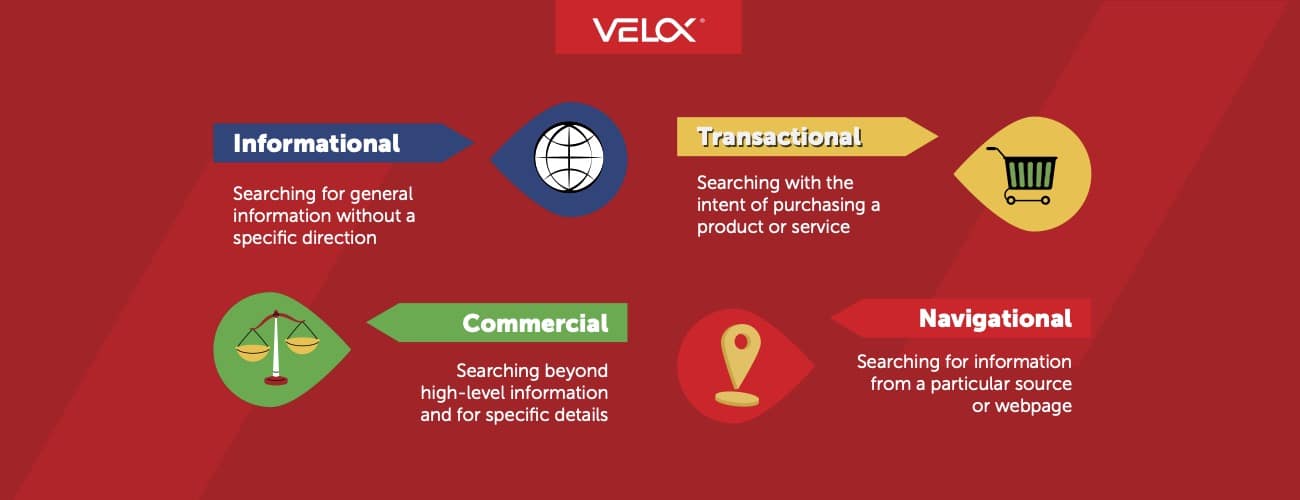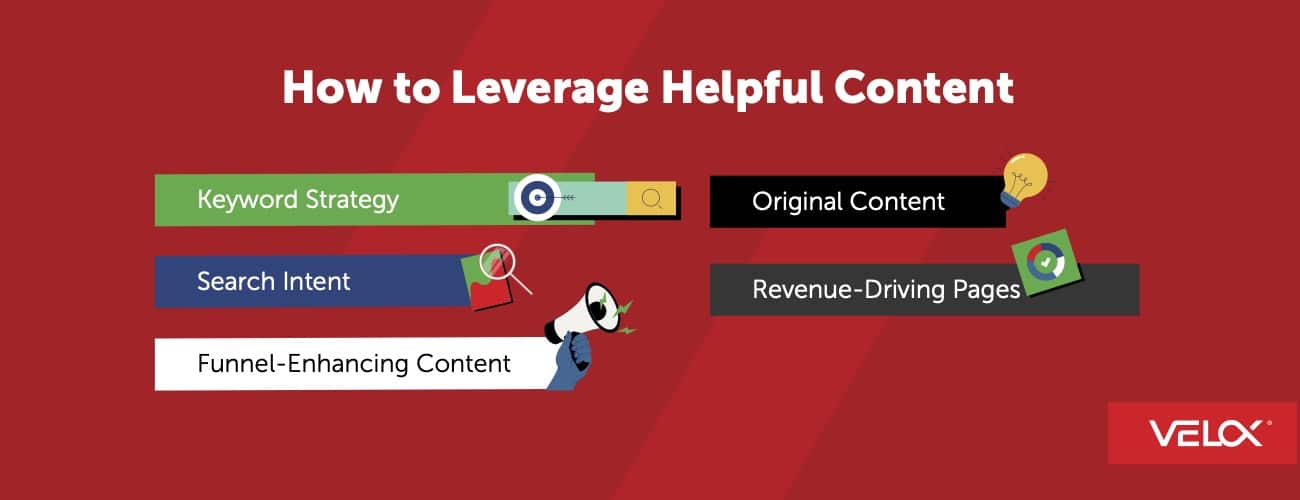
October 23, 2023
Informative eCommerce: 5 Keys to Selling Through Helpful Content
Driving revenue is a fundamental element of scaling your business, and for e-commerce enterprises, that means getting more traffic to product pages.
However, in the wake of Google’s Helpful Content Update, these revenue-driving product pages are at a disadvantage.
Google wants to provide searchers with the most valuable results by surfacing educational, informative, and useful results. Put simply, Google prioritizes helpful content. Historically speaking, product pages aren’t known as the repositories of practical knowledge that searchers will find meaningful.
But that doesn’t mean your product pages are dead in the water.
In fact, optimizing your e-commerce site and enhancing your conversion rate is as simple as following Google’s advice and creating content searchers actually want to read.
Still, that’s easier said than done. Use this guide to optimize your pages by creating and incorporating high-quality, helpful content to achieve the visibility your brand needs to grow.
What Types of Helpful Content Are Right for e-commerce Sites?

Some content works best for businesses in certain verticals, while other types of site content will work for any brand.
Whichever you decide to publish in the course of your e-commerce content optimization, keep Google’s guidance in mind. By the search giant’s definition, their ranking systems prioritize “helpful, reliable, people-first content.”
That means your content team needs to write with your brand’s buyer personas in mind and approach content from the customer’s perspective rather than simply listing off why you think your products are better than the competition.
Here are five types of content that work well for e-commerce sites looking to boost search visibility.
Detailed Product Descriptions
Every product page needs a description. But if you’re using boilerplate descriptions across entire categories, your ranking signals will most likely get lost, preventing your pages from ranking better on SERPs.
Unique product descriptions that thoughtfully incorporate relevant keywords as part of your overall keyword strategy are crucial.
Informative Buying Guides
Buying guides can be extremely valuable. Typically, you’d want to feature them as standalone pages rather than add them to product pages since this will give you opportunities to add internal links between the two.
Buying guides also give you plenty of real estate to include keywords as well as rich media such as high-quality images and product comparison carousels.
FAQ Answers
FAQs are practically a must. In fact, because well-executed FAQs align so well with Google’s guidance on creating helpful content, they present opportunities for easy content optimization wins.
Depending on your product offerings, FAQs could give you a chance to get granular. There’s nothing wrong with settling for one FAQ that covers an entire site or brand, but you may find it beneficial to assemble product-specific FAQs and publish them on the appropriate product pages. Pay attention to customer reviews for common misconceptions, or consult your customer service team so you can answer the questions your customers ask the most.
How-To Guides
Product-specific how-to guides present a practical, in-demand resource for customers at the bottom of the funnel, making this type of content a superb remarketing vehicle for your brand.
How-to guides are more than just valuable on-site content for e-commerce brands. This type of content is also ideal for link building for a number of reasons, not the least of which is the organic shareability of how-to guides.
You can go as far as you want with these guides. You don’t have to stop at product use cases—you can cover adjacent topics relevant to your lookalike audiences to cast a wider net.
Educational Content

By now you’ve likely noticed effective e-commerce content isn’t limited to users with strictly transactional intent. Perhaps you’ve noticed competing businesses with a “resources” or “learning center” tab on their site featuring broader content to educate industry newcomers.
This type of content is extremely valuable as it gives you the opportunity to carefully craft the top of your funnel based on your priority audience, product use cases, and your unique position within the market.
Plus, high-quality educational pieces also just so happen to align exceedingly well with Google’s E-E-A-T and helpful content guidelines.
Both educational content and how-to guides can serve as the backbone of your blog, so approach these pieces with a publishing strategy and content map in mind.
Publishing regularly with consistent quality and messaging will make your blog a quintessential resource for the audiences that matter most to your brand.
With an understanding of the various type of effective e-commerce content, what steps do we need to take to create best-of-web pages?
How to Leverage Helpful Content on e-commerce Sites
Now, let’s dive into the most effective techniques for leveraging content for e-commerce conversion rate optimization.
But first, a quick reiteration of the people-first ethos.
The value props that catch investors’ attention may not be the same factors that compel users to convert, so ensure your content prioritizes your target audiences and emphasizes how your products will improve their lives.
In a sense, creating “people-first” content means consciously not designing content with the primary goal of performing well on search engines.
Instead, Google wants to do the designing, continuing to refine Search to satisfy searchers’ intent with the most relevant, high-quality content on the web. They don’t want digital marketers making educated guesses about how Google’s ranking systems work and using those conclusions as a basis for content creation.
Essentially, it’s a bit of guidance we have to follow without following. Obviously, people-first content is vital, but you can still leverage the latest intelligence about keyword inclusion, link building, and other factors as you write so long as your content isn’t merely a vehicle for links and keywords without any tangible value.
In short, write content for the people who will be reading it, not for Google’s crawlers.
With that understood, here are the five keys your e-commerce businesses should use to optimize pages within the context of Google’s Helpful Content Update.

1. Incorporate a Well-Researched Keyword Strategy
Keyword research is the process of understanding how people use search engines to find your products. It’s also how you’ll uncover the keywords best suited to maximize organic search revenue.
Some enterprises have an adequate war chest to target prized high-volume, high-difficulty keywords.
In other cases, optimal ROI is realized through innovative tactics that prioritize quick wins and low-hanging fruit while occasionally forcing competitors to overspend to maintain meaningful rankings for their revenue-driving pages.
Often, e-commerce brands target long-tail keywords that offer a balance of relatively low competitiveness and high conversion rates. Users typically query these long-tail keywords with a transactional search intent, such as “the best boot for winter skiing” or “jeans for guys with long legs.”
And that leads us to the next critical element of e-commerce content optimization.
2. Satisfy Search Intent
Here’s the big picture view: If your site gives searchers what they’re after, Google will recognize it and reward you with the visibility you need to drive revenue and scale.
So, satisfying search intent is imperative in both your keyword strategy and content creation work.
Be it a how-to guide, FAQ answer, or educational resource, your content shouldn’t just focus on your target keyword but also cover topics semantically related to that keyword.
Ideally, your content will position your brand as a trusted source within your industry for people looking to learn, shop, and purchase.
To do that, your content should be robust, digestible, and shareable, so cover adjacent topics and provide the context your competitors are missing on their pages. This will help achieve our next goal: using e-commerce content to build better funnels.
3. Structure Content to Enhance Your e-commerce Funnels
It’s clear now that helpful content has tremendous power to enhance e-commerce funnels. Of course, there’s no one-size-fits-all approach here, and your funnels will ultimately be unique based on your target audiences, products, and business structure.
That said, there are a few clear starting points from which you can build.
For instance, educational content and how-to guides are ideal top-of-funnel elements. These topics are relevant to people searching for products like yours and can help introduce them to your brand—all without the hard sell. They’re also perfect for link building, a crucial part of off-page SEO that will help users and search engines recognize your brand as an industry leader.
Buying guides and FAQs are generally right at home in the middle of a funnel, as they shepherd users toward the products on your site that are best suited to satisfy their needs.
Finally, comprehensive, compelling product descriptions are key to conversions and revenue capture.
4. Avoid the Template Trap
Whether it’s featured on a product page or a how-to guide, winning content must be more than helpful—it also has to be original. Duplicate content won’t stand out in the eyes of search algorithms or users and almost invariably falls to the bottom of search results.
As an enterprise, content templates have quite the allure, especially when it comes to product descriptions and FAQs. But this is an area that requires you to be diligent and judicious.
In most cases, the risk of producing duplicative content outweighs the efficiencies you’d realize by cutting corners with templates or content wholly generated by AI.
That isn’t to say AI isn’t a valuable tool for e-commerce SEO and some aspects of content creation. However, close human oversight is essential.
People and search algorithms alike are more than capable of recognizing content that was either hastily produced or simply generated by AI. This is recognized as a site deficiency when identified, and you can bet your visibility will suffer for it.
Even as AI tools become increasingly capable, there’s still no substitute for original, world-class content created by people, for people.
Will creating unique descriptions for each product in your e-commerce store will be a ton of work? Definitely, but the dividends are incomparable, and they include the superior ROI your business needs to scale.
5. Prioritize Your Revenue-Driving Pages
Depending on the number of pages you need to optimize, revamping your site with effective e-commerce content can seem like a daunting task.
But by prioritizing your revenue-driving pages in your content optimization work, you’ll start to see benefits sooner rather than later.
Ordering pages by conversion metrics is certainly an effective technique. But you could also identify pages with an off-kilter ratio of traffic to conversions, where enhanced content could be a difference maker.
Creating pillar content within a category is another clever way to help users quickly navigate to the products on your site they will value most.
Regardless of the tactics you employ, you’ve got your work cut out for you.
But with the right e-commerce digital marketing agency at your side, you can quickly enhance your brand’s online presence without expending the time and treasure it takes to build an in-house content optimization team.
Boost Visibility, Conversions, and Revenue with VELOX
Growing your enterprise e-commerce business doesn’t just take better rankings—it requires new revenue and next-level ROI. When you partner with VELOX, our SEO and PPC specialists will build you a tailored campaign using the latest business intelligence and technology.
We’ll identify target keywords and use our New Revenue Model to show you exactly how much new monthly revenue your campaign will contribute to your bottom line. As a Google Premier Partner, we rank among the top 3% of agencies worldwide because we consistently deliver results that exceed client expectations.
Contact VELOX today to learn more about our New Revenue Model and how improving your search visibility could impact your bottom line.